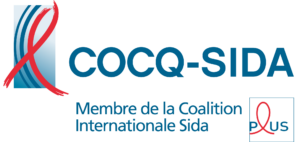Your cart is currently empty!

At-Home HIV Test: How to Analyze Your Drop of Blood

Presented by COCQ-SIDA, the Coalition des organismes communautaires québécois de lutte contre le sida.
In November 2020, the at-home human immunodeficiency virus (HIV) test was launched in Canada, an important milestone in HIV testing accessibility. Until then, HIV testing had been done exclusively in clinics. I discussed this with three members of the Coalition des organismes communautaires québécois de lutte contre le sida (COCQ-SIDA): Martine Fortin, Project Coordinator; Tanguy Hedrich, Community Research Coordinator; and Ken Monteith, Managing Director.
“One of the greatest advantages of the at-home HIV test is its confidentiality and the independence it offers people who can now choose when they want to get tested,” explains Martine.
It should be noted that, for many people, simply having to go to a clinic and having to interact with medical staff is a major obstacle to getting tested.
Why has it taken so long for this test to be available in the maple leaf country when its southern neighbours have had different versions of it for years? It’s simple: in Canada, before a health product can be marketed, it must first be approved by Health Canada, at the expense of the pharmaceutical company. Due to its small population, Canada is not considered a major market for self-testing. Communities have long fought to convince companies to market at-home HIV tests.
“Commercializing the at-home HIV test in Canada was daunting for companies that had to invest a lot for little return,” says Ken, who is relieved that all the efforts made to get to this point have finally paid off.
As I am writing these words, the only at-home HIV test available to Canadians is blood drop analysis. REACH Nexus, a national research group, is conducting clinical trials so that an at-home oral HIV test can be distributed in Canada by the end of 2022 or early 2023. (We send them our support and admiration!)
How does the at-home HIV test work?
Once barriers to accessibility are overcome, we quickly realize that the test is quite simple to take, even easier than the COVID rapid tests. Each testing kit comes with an illustrated instruction booklet. Other tools, like this video, help you understand each step. You can also get support from community organizations, but they can’t perform the test for you (i.e., prick your finger).
“In Quebec, testing is considered a medical act, and therefore, only medical staff can prick someone else’s finger. Community workers can provide moral support, but they cannot [administer] the test,” says Ken. He adds that at-home tests are a good solution, because the law doesn’t prohibit anyone from pricking their own finger.
The at-home test is carried out in seven steps:
- Wash and dry your hands.
- Prick your fingertip to produce a drop of blood (this step is probably the trickiest. We recommend warming or applying pressure to your finger to make it easier!).
- Get the drop of blood into the first vial (the small red bottle), making sure that you don’t touch it with your finger.
- Cap the vial shut, shake it, pour its contents into the test device provided for this purpose, and wait a few seconds for the liquid to drain into the device.
- Shake the second vial (the small blue bottle), pour its contents into the test device (the same used in the previous step), and wait a few seconds for the liquid to drain into the device.
- Shake the third vial (the small grey bottle), pour its contents into the test devicer (the same used in the two previous steps), and wait a few seconds for the liquid to drain into the device.
- Wait for the result, which will appear in just sixty seconds.
Note that the at-home test can only detect an infection three to twelve weeks after exposure. This is called the window period.
How can one obtain an at-home HIV test?
Accessibility turns out to be the Achilles heel of at-home HIV testing. At present, this test is only offered online from bioLytical Laboratories, the biotechnology company that manufactures the test. It costs $57 for one test or $85 for two, taxes and shipping included.
You can also get a free testing kit through the I’m Ready research program. To participate, simply follow these steps:
- Download the I’m Ready, Test mobile application.
- Consent to participate, create a profile, and complete the survey.
- Have up to three self-testing kits delivered to your home (or to a partner organization).
- Perform the test by following the instructions on the application.
- Save your result anonymously.
Participants not only get a free test, but they also contribute to the fight against HIV in Canada. All the more reason to choose this option!
“We obviously won’t succeed in reaching marginalized populations with a $57 test. However, the I’m Ready program will allow us to justify our requests for government subsidies. Ultimately, what we want is for the healthcare system to assume, in whole or in part, the costs and distribution of at-home HIV tests across Canada,” explains Tanguy.
Through the ongoing REACH Nexus study, over 8,000 tests have been distributed throughout Canada. The tests have detected five positive cases, two in people who were taking an HIV test for the first time.
“With self-tests, we can reach people who don’t necessarily have access to a testing clinic or to the healthcare system, like international students,” adds Martine.
She stresses the importance of offering several testing options to the Canadian population, so that, among other things, people who have never been tested do so today.
What if the result is positive?
While the self-test is easily done in a matter of minutes, the events that follow a positive test result are harder to face.
“The most important thing is the period after getting the positive result. This is where community organizations come in. In 2022, testing positive isn’t the end of the world, but you have to know how to surround yourself with sources of support, go through each step, and be guided by a doctor,” says Ken, who tested positive several years ago.
Among the different steps to go through are obtaining psychological support, consulting a doctor to confirm the result, receiving care, and starting treatment for HIV. It cannot be said often enough: the earlier HIV is detected, the easier it is to treat it.
What if the result is negative?
Before rejoicing, ask yourself if the test was carried out long enough after exposure, that is, during the window period. Most people will have a reliable result three to six weeks after exposure, but for a small number of people, the window period can be as long as twelve weeks. If there is any doubt that the test may have been performed too soon, it’s important to take a second test later to confirm the first test result.
Regardless, Martine, Ken, and Tanguy are unanimous: it’s never too early or too late to prevent infection. Obtaining a negative result may be a good time to consider different preventive options, such as taking PrEP, or even PEP. There is plenty of information about different protection methods on our DépistaFest website. Also, it’s always possible to contact a community worker to learn more about the different ways to prevent HIV infection.
Whether it’s because you’ve had unprotected sex or because you’ve never been tested for HIV, it’s never a bad time to get tested. Get your at-home HIV testing kit by visiting I’m Ready or make an appointment to go get tested at one of DépistaFest’s partner clinics or by consulting this map of HIV and STBBI screening clinics in Quebec.





